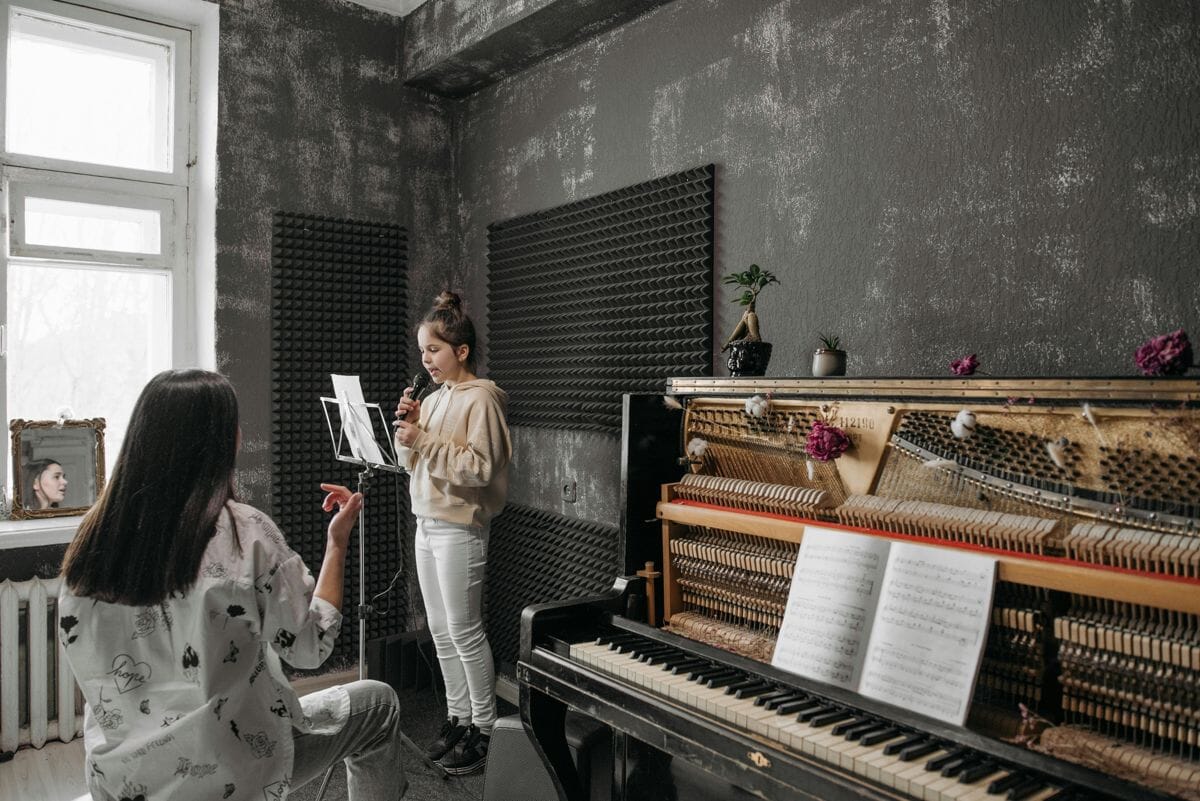Overtone Acoustic Solutions
Overtone Acoustic Solutions
How to Soundproof a Room on a Budget
How to Soundproof a Room on a Budget
If you’re building a budget studio or just want an affordable way to make your home quieter, we’ve got you covered. Noise from busy streets and loud neighbors can disrupt our peace and productivity.
At Overtone Acoustics, we have everything you need to soundproof a room. And, if your budget is tight, we have practical recommendations that won’t break the bank.
Understanding Soundproofing
At its core, soundproofing is the process of reducing the transmission of sound through a particular space. The challenge in effectively soundproofing a room lies in the complex nature of sound waves, which can diffract around obstacles and penetrate through the smallest of gaps. Fundamentally, sound can be categorized by its frequency: high-pitched noises, such as children's voices or dog barks, are more difficult to block due to their shorter wavelength and higher frequency, while low-frequency sounds like the rumble of traffic or the bass in music travel farther and penetrate deeper. Effective soundproofing solutions must address a broad spectrum of sound frequencies, employing techniques that absorb, dampen, and isolate sound to create a more acoustically serene environment.
Identifying Noise Sources
To soundproof a room effectively, you’ll need to identify the primary sources of noise intrusion. Noise can come from external sources, like traffic or neighbors, or from within the building itself. External noise typically enters through windows, doors, and even walls, while internal noise might spread across rooms through floors and ceilings.
Pay close attention to where the most noise comes from in your home, and make that the first surface you target with your soundproofing strategy.
Affordable Soundproofing Strategies
Windows
Noise-reducing windows and proper seals are the best ways to reduce noise coming through windows. For a budget-friendly approach, consider applying acoustic caulk to seal any gaps around window frames, a common entry point for noise. Window films, though less effective for soundproofing, can offer a temporary reduction in noise transmission.
For better results, installing secondary glazing or using heavy curtains designed to dampen sound can offer a noticeable decrease in noise levels.
Walls
Walls can act as conduits for noise, especially from adjoining rooms or apartments. Utilizing acoustic panels is a common method for dampening sound. Ours are super affordable, but the costs can add up if you need a lot of them.
As an alternative, exploring the use of dense materials like mass-loaded vinyl can add an extra layer of sound insulation without breaking the bank. For DIY enthusiasts, filling bookshelves with books against noise-sharing walls can dampen the sound. Adding bass traps in corners where sound tends to accumulate can help in minimizing the echo within a room.
Floors and Ceilings
Addressing noise from floors and ceilings is a must in multi-story homes or apartments. For floors, laying thick rugs or carpets can absorb sound and reduce noise from foot traffic. This approach is both effective and enhances the room's aesthetics.
For ceilings, installing acoustic tiles can help dampen sound from above. If you can’t add these kinds of tiles to your ceiling, your best bet is mass-loaded vinyl.
DIY Soundproofing Tips
For those seeking quick, affordable fixes to noise without renovations, there are numerous DIY strategies that can make a significant difference. Furniture, such as bookshelves filled with books, serve as an effective sound barrier that enhances the aesthetic appeal of a room. Installing wooden shutters or using heavy, sound-dampening curtains can significantly reduce noise from outside.
For a more hands-on approach, sealing gaps in windows and doors with acoustic caulk prevents sound leaks effectively. Incorporating soft furnishings like rugs and carpets can dampen echo and absorb sound as well.
Final Thoughts on Affordable Soundproofing
Creating a peaceful environment through soundproofing doesn’t have to break the bank. You can significantly reduce unwanted noise in your home through a combination of the strategies discussed. Remember, combining various methods often yields the best results, as it addresses multiple sources and noise transmission paths. With some creativity and effort, you can transform your space into a quiet one without spending too much.
If you’re building a budget studio or just want an affordable way to make your home quieter, we’ve got you covered. Noise from busy streets and loud neighbors can disrupt our peace and productivity.
At Overtone Acoustics, we have everything you need to soundproof a room. And, if your budget is tight, we have practical recommendations that won’t break the bank.
Understanding Soundproofing
At its core, soundproofing is the process of reducing the transmission of sound through a particular space. The challenge in effectively soundproofing a room lies in the complex nature of sound waves, which can diffract around obstacles and penetrate through the smallest of gaps. Fundamentally, sound can be categorized by its frequency: high-pitched noises, such as children's voices or dog barks, are more difficult to block due to their shorter wavelength and higher frequency, while low-frequency sounds like the rumble of traffic or the bass in music travel farther and penetrate deeper. Effective soundproofing solutions must address a broad spectrum of sound frequencies, employing techniques that absorb, dampen, and isolate sound to create a more acoustically serene environment.
Identifying Noise Sources
To soundproof a room effectively, you’ll need to identify the primary sources of noise intrusion. Noise can come from external sources, like traffic or neighbors, or from within the building itself. External noise typically enters through windows, doors, and even walls, while internal noise might spread across rooms through floors and ceilings.
Pay close attention to where the most noise comes from in your home, and make that the first surface you target with your soundproofing strategy.
Affordable Soundproofing Strategies
Windows
Noise-reducing windows and proper seals are the best ways to reduce noise coming through windows. For a budget-friendly approach, consider applying acoustic caulk to seal any gaps around window frames, a common entry point for noise. Window films, though less effective for soundproofing, can offer a temporary reduction in noise transmission.
For better results, installing secondary glazing or using heavy curtains designed to dampen sound can offer a noticeable decrease in noise levels.
Walls
Walls can act as conduits for noise, especially from adjoining rooms or apartments. Utilizing acoustic panels is a common method for dampening sound. Ours are super affordable, but the costs can add up if you need a lot of them.
As an alternative, exploring the use of dense materials like mass-loaded vinyl can add an extra layer of sound insulation without breaking the bank. For DIY enthusiasts, filling bookshelves with books against noise-sharing walls can dampen the sound. Adding bass traps in corners where sound tends to accumulate can help in minimizing the echo within a room.
Floors and Ceilings
Addressing noise from floors and ceilings is a must in multi-story homes or apartments. For floors, laying thick rugs or carpets can absorb sound and reduce noise from foot traffic. This approach is both effective and enhances the room's aesthetics.
For ceilings, installing acoustic tiles can help dampen sound from above. If you can’t add these kinds of tiles to your ceiling, your best bet is mass-loaded vinyl.
DIY Soundproofing Tips
For those seeking quick, affordable fixes to noise without renovations, there are numerous DIY strategies that can make a significant difference. Furniture, such as bookshelves filled with books, serve as an effective sound barrier that enhances the aesthetic appeal of a room. Installing wooden shutters or using heavy, sound-dampening curtains can significantly reduce noise from outside.
For a more hands-on approach, sealing gaps in windows and doors with acoustic caulk prevents sound leaks effectively. Incorporating soft furnishings like rugs and carpets can dampen echo and absorb sound as well.
Final Thoughts on Affordable Soundproofing
Creating a peaceful environment through soundproofing doesn’t have to break the bank. You can significantly reduce unwanted noise in your home through a combination of the strategies discussed. Remember, combining various methods often yields the best results, as it addresses multiple sources and noise transmission paths. With some creativity and effort, you can transform your space into a quiet one without spending too much.




